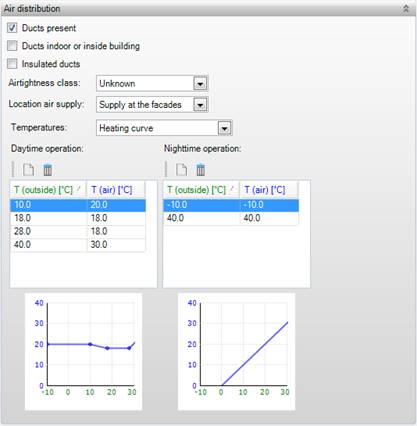

EPG
This box indicates
ducts are present for the ventilation system. In case of a central system with
air ducts a correction is applied to the chargeable ventilation capacity
depending on the airtightness class of the ducts.
EPG
In this box it can be
indicated whether the ducts are indoor or inside the building. This is used in
the energy performance calculation EPG for housing; in case of non-residential
building this option does not affect the results. This box only appears when
ducts are present as well as a heating coil in the system. The distribution
efficiency for the heating system is determined partially based on this
checkbox.
|
|
NEN 7120, Table 14.2 |
EPG
In this box it can be
indicated that the ducts have been insulated, which affects the energy
performance EPG calculation both for housing and non-residential buildings. This
box only appears when ducts are present as well as a heating coil in the system.
The distribution efficiency for the heating system is determined partially based
on this checkbox.
|
|
NEN 7120, Tables 14.2 and 14.5 |
EPG
The airtightness
class of the air ducts in the system can be specified here. This parameter is
only asked for if air ducts are present. A correction to the chargeable
ventilation capacity is applied based on the airtightness class.
•Unknown
•Class A
•Class B
•Class C
•Class D
|
|
NEN 8088, Table 4 |
EPG
In case of housing,
it is indicated whether a central supply or a supply at the facades is applied.
This distinction is used in the energy performance calculation. The location of
air supply is only asked for if air ducts are present and a heating coil has
been specified. The distribution efficiency of the heating system is determined
partly based on the location of air supply.
•Central supply
•Supply at the facades
|
|
NEN 7120, Table 14.2 |
BS
The heat curves are important in the air handling
unit to optimize the energy reduction. In temperatures,
the heating curve is determined, which can be done in one of the following three
ways:
•Default; In this setting a constant temperature of 18 °C is applied in both daytime and night time operation;
•Constant: In this setting a constant, user specified, temperature is applied in both daytime and night time operation;
•Curve: The complete heating curve is defined manually. For all values of outside temperature (Toutside) a value of the heating- or cooling water (Twater) can be specified. Separate curves can be defined for daytime operation and night time operation.
|
|
ISSO Publication 68 (2002) Energetically optimal heating and cooling curves for air-conditioning systems in office buildings
|